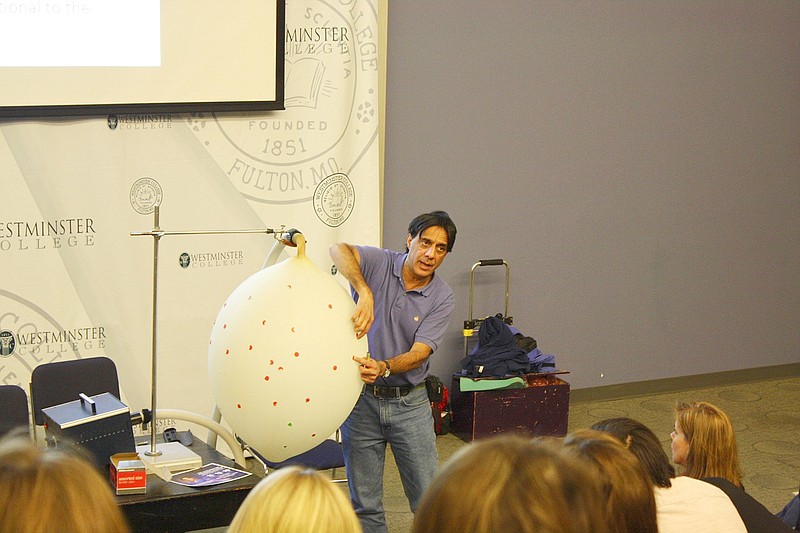Distinguished physics professor Bharat Ratra lectured Tuesday evening at Westminster College to put the expanding universe in perspective.
The Kansas State University professor addressed the crowded lecture hall in the Coulter Science Center where he shared research he completed with Nobel Prize-winning physicist Jim Peebles. Ratra's lecture was titled "The Accelerating Expanding Universe: Dark Matter, Dark Energy and Einstein's Cosmological Constant."
"Cosmology is a really, really interesting field right now, and the reason it's really interesting is because we have really great observational data that's coming in from telescopes in space that have really sensitive detectors," Ratra said.
In 1988, Ratra and Peebles introduced the first dynamical dark matter model, which is a theory on how dark matter physics work. Since then, the model has been adjusted as more has been discovered and understood about so-called dark matter and dark energy, which is now believed to make up a majority of the mass-energy of the universe.
As physicist Albert Einstein's theory of special relativity shows, anything that has mass also has a certain amount of energy and vice versa.
However, existing astronomical instruments can't pick up on dark matter because it doesn't interact with electromagnetic radiation (including light). Astronomers though believe it exists - one reason being if the universe was composed only of visible matter, its mass would be so much lower that many galaxies would fly apart instead of being held together by gravity.
Dark energy seems even more like science fiction. It's an as-yet unknown type of energy believed to be the reason the universe continues expanding at an accelerating rate, rather than slowing or contracting due to gravity.
"We do not understand 95 percent of the current cosmological energy budget, but we do have a 'standard' model of cosmology," Ratra said.
During his lecture, Ratra demonstrated the size of the expanding universe by starting with scales as small as a proton and gradually getting larger. He used a variety of scales and the time it would take to travel across them to put the varying sizes in perspective all the way to the full universe.
"It would take 160,000 years to cross the Milky Way at the speed of light, but when compared to the Virgo Cluster of galaxies, that would take 15 million years to cross at the speed of light," Ratra said.
He also discussed an early pioneer in the study of the universe's expansion: astronomer Vesto Slipher, who first theorized about the "redshift" in the early 1900s. While observing the light emitted from galaxies, Slipher noticed some he expected to emit a certain wavelength of light were instead emitting a lower wavelength - for example, red light instead of blue. The farther away the object, the greater the shift. Later astronomers concluded this meant the objects were moving away from Earth, meaning the universe must be expanding.
Imagine an ambulance driving past you with its sirens blaring - as it zooms into the distance, the sirens' pitch seems to decrease. That's the same principle.
"Dark matter has existed since the beginning of the universe, and it is the reason the universe expands. It's a very difficult concept to grasp," Ratra said.

